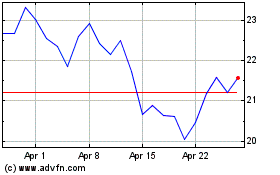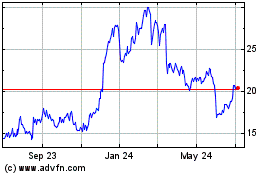Sprint Demonstrates What’s Next for LTE Plus with Three-Channel Carrier Aggregation Reaching 295 Mbps on HTC 10
August 12 2016 - 2:15PM
Business Wire
Sprint continues device testing in preparation
for LTE Plus network deployment
Sprint (NYSE: S) today announced it reached peak speeds of 295
Mbps in three-channel carrier aggregation lab tests using the HTC
10, one of the first devices on the market to support the
functionality. Sprint is testing three-channel carrier aggregation
in its labs to evaluate overall performance, speed, and reliability
as it prepares for LTE Plus network deployment.
Carrier aggregation is an LTE-Advanced feature that bonds
together bands of spectrum to create wider channels and produce
more capacity and faster speeds on capable devices. Essentially it
creates a wider lane that allows more data traffic to travel at
higher rates.
Today Sprint offers 22 devices that actively support two-channel
carrier aggregation on its super-fast LTE Plus network. In its labs
in March, Sprint demonstrated speeds of more than 300 Mbps using
three-channel carrier aggregation on a Samsung Galaxy S7. Five
devices currently offered by Sprint are three-channel carrier
aggregation capable: the HTC 10, HTC 9, LG G5, Samsung Galaxy S7,
and Samsung Galaxy S7 Edge. Three-channel carrier aggregation is
slated for enablement on devices via an automatic software update
following network deployment.
Sprint LTE coverage reaches approximately 300 million people –
more than 90 percent of the U.S. population. Two-channel carrier
aggregation used by Sprint today delivers peak speeds of more than
100 Mbps in 237 LTE Plus markets across the country using 40MHz of
spectrum on the company’s 2.5GHz cell sites. With three-channel
carrier aggregation Sprint will utilize 60MHz of spectrum to
provide peak speeds of more than 200 Mbps on compatible
devices.
“LTE Plus uses some of the most advanced technologies in
wireless such as carrier aggregation and it’s a key part of our
Densification and Optimization strategy,” said Günther Ottendorfer,
Sprint COO, Technology. “With LTE Plus we’ll keep delivering the
best mobile services for our customers with higher throughput and
capacity using very cost-efficient solutions.”
Sprint’s LTE Plus network expansion and the use of carrier
aggregation have driven significant improvements in download speeds
nationwide, as recognized by its millions of customers and
third-party organizations. For example, PC Magazine’s 2016 Fastest
Mobile Networks report recently found that Sprint showed
“spectacular” peak download speeds nationwide, and Sprint beat
T-Mobile and AT&T in average download speeds.
“Two-channel carrier aggregation has made a significant
difference for our customers in LTE Plus markets across the country
and that’s just the beginning,” said Dr. John Saw, Sprint CTO.
“With holdings of more than 160MHz of 2.5GHz spectrum in the top
100 U.S. markets, we have more capacity than any other carrier in
the U.S. Our customers and those switching to Sprint can be
confident in our ability to meet their demand for data now and well
into the future.”
About Sprint:
Sprint (NYSE: S) is a communications services company
that creates more and better ways to connect its customers to
the things they care about most. Sprint served more than 59.4
million connections as of June 30, 2016 and is widely recognized
for developing, engineering and deploying innovative technologies,
including the first wireless 4G service from a national carrier in
the United States; leading no-contract brands including Virgin
Mobile USA, Boost Mobile, and Assurance Wireless; instant national
and international push-to-talk capabilities; and a global Tier 1
Internet backbone. Sprint has been named to the Dow Jones
Sustainability Index (DJSI) North America for the past five years.
You can learn more and visit Sprint at www.sprint.com or
www.facebook.com/sprint and www.twitter.com/sprint.
View source
version on businesswire.com: http://www.businesswire.com/news/home/20160812005684/en/
SprintAdrienne Norton,
425-256-7014adrienne.norton@sprint.com
SentinelOne (NYSE:S)
Historical Stock Chart
From Mar 2024 to Apr 2024

SentinelOne (NYSE:S)
Historical Stock Chart
From Apr 2023 to Apr 2024
